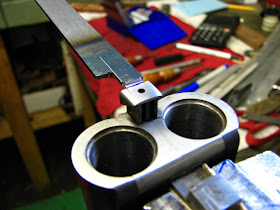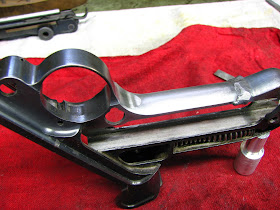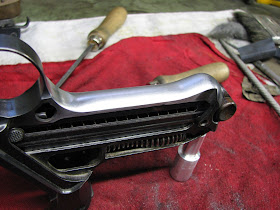One issue common to Parkers (and Parker Repros) is failure of the ejector retainer. While most ejector doubles rely upon a large diameter pin acting upon the extractor shanks to retain them, Parker chose to use a system whereby the extractor segments are retained by a very thin plate that is shallowly dovetailed into the rib extension. This shallow dovetail bears the not inconsiderable brunt of halting the extractor segments' rearward travel after the ejectors are tripped.
As would be expected, this dovetail is not long-lived in a gun that sees much use. Here I will detail the repair of a failed retainer.
The failed dovetail can be plainly seen as the metal curled up on either side of the slot.
First I peen the displaced back into place and then I recut the dovetail on either side using a file modified strictly for this purpose.
I then fashion a new retainer plate blank from high carbon steel (1075) as it will be hardened and tempered
After the blank is fitted I drill the hole for the retaining screw. This screw does not clamp the plate in place, it retains the plate by preventing its vertical movement.
The blank is then cut from the raw stock leaving extra material for exterior fitting.
The plate is then carefully filed to the contour of the rib extension.
It is then hardened, polished and tempered.
The job is finished.
Lititz, PA 717-626-4226 Dewey@VicknairRestorations.com
Wednesday, September 3, 2014
Thursday, July 10, 2014
Remington Smoot revolver
This revolver was missing the entire ejector rod assembly which had to be fabricated from scratch based upon photographs.
Un-drilling a Fox
So far we've seen the results of the incorrect application of screwdriver, hammer, punch and grinder.
Here is an example of just one way to misuse a drill. Apparently the extractor guide pins broke and drilling holes (multiple) on the barrel flats to knock them out seemed like a good idea.
Notice the rough, original finish of the barrel flats. This finish must be maintained and this area is a perfect example of the difference between "nice" and "correct" that often arises in restoration work.
If this were a custom job, the barrel flats and hidden areas would be filed and polished in the same manner as the other exterior surfaces.
The holes are TIG welded.
Then filed....
...and blued.
Of course I also made and installed new guide pins for each extractor segment to complete the repair.
Here is an example of just one way to misuse a drill. Apparently the extractor guide pins broke and drilling holes (multiple) on the barrel flats to knock them out seemed like a good idea.
Notice the rough, original finish of the barrel flats. This finish must be maintained and this area is a perfect example of the difference between "nice" and "correct" that often arises in restoration work.
If this were a custom job, the barrel flats and hidden areas would be filed and polished in the same manner as the other exterior surfaces.
The holes are TIG welded.
Then filed....
...and blued.
Of course I also made and installed new guide pins for each extractor segment to complete the repair.
Wednesday, July 9, 2014
Rescuing a rare Luger
Here is a 1910 DWM commercial Luger that someone, for reasons unknown, customized with a grinder - right through the front strap. Many (but not all) military issue Lugers had unit markings stamped on their front straps but commercial Lugers should not (usually) have any front strap markings, so who knows what the perpetrator of this heinous deed was thinking. Whatever the reason, what's done is done. Luckily some things that are done can be un-done and here is the process in detail.
Here is what it looked like to start. Notice the amount that the grips overhang at the front edge, this is absolutely correct for a Luger of this vintage and make.
Here is a shot with the grips removed and the front strap marked at the approximate cut points.
In these photos you can see that I've sectioned the front strap, machined a new piece to fit and I've also machined a welding jig/alignment fixture from aluminum to hold the new piece in place while preserving the frame alignment during welding. The jig will also prevent the molten steel from simply dropping through while welding on the thinner areas of the strap.
Here is the new piece welded in place.
The top weld is filed and polished.
The bottom weld roughly filed up.
All filed up and polished and ready to be rust-blued.
Here is the finished job.
Here is what it looked like to start. Notice the amount that the grips overhang at the front edge, this is absolutely correct for a Luger of this vintage and make.
Here is a shot with the grips removed and the front strap marked at the approximate cut points.
In these photos you can see that I've sectioned the front strap, machined a new piece to fit and I've also machined a welding jig/alignment fixture from aluminum to hold the new piece in place while preserving the frame alignment during welding. The jig will also prevent the molten steel from simply dropping through while welding on the thinner areas of the strap.
Here is the new piece welded in place.
The top weld is filed and polished.
The bottom weld roughly filed up.
All filed up and polished and ready to be rust-blued.
Here is the finished job.
Tuesday, July 8, 2014
How NOT to use a punch and hammer...
The rib was loose on this Fox J grade SBT so naturally, some "gunsmith" decided to tighten it (with a hammer, of course). Apparently the hands weren't too steady. I disassembled the rib from the barrel, machined a new anchor post and pin and proceeded to undo the punch damage. I then reassembled the rib, properly swaged the anchor post and then filed it flush to the rib. Finally, I re-matted the rib and prepared the barrel for bluing. This was just one of many issues that this gun had.
Monday, July 7, 2014
Screwdriver abuse
Ill-fitting, improper screwdrivers and the people who carelessly wield them account for the single most common job in the shop, making new screws. Few things can spoil the appearance and value of an otherwise nice gun the way butchered screw slots can. The procedure is as follows, turn the new screw from barstock on the lathe, leaving the head extra long. Then cut a temporary slot, install the screw with the proper torque and mark the height of the head and the final slot orientation. The excess head is cut off and then the screw slot is cut in a fixture designed for the purpose. The screw is reinstalled and the head is carfeully contoured, then the screw is removed, the appropriate engraving is performed and then it is appropriately finished and if needed, the finish is artificially aged to match its surroundings. I use a 20X microscope and push gravers to do all of the engraving.
Here are some examples from an Ithaca Baker model SBT.
These are the triggerplate and breech screw s for a Crown grade L.C.Smith.
Here are some examples from an Ithaca Baker model SBT.
These are the triggerplate and breech screw s for a Crown grade L.C.Smith.
Welcome
Welcome to my gunsmithing weblog where I will be documenting some of the more interesting repair and restoration work that comes in to the shop. My philosophy regarding repairs and restoration is as follows, a repair is only done right if it is completely undetectable, no ifs, ands or buts. Restoration work must be done in accordance with the factory methods and the results must be identical to the factory's work, otherwise it is simply refinished, no matter how "nice" it looks. Restoration is a word that is well overused in gunsmithing today by many who have no idea of how to do it properly. Correctly done, a repair or restoration will enhance the value of a collectible firearm while poorly done repairs or refinishing will have the opposite effect. I do not do "general gunsmithing" like mounting scopes or installing sling swivels. I do only specialized and custom gunsmithing. You may find someone cheaper or faster but I guarantee that you will not find better quality work anywhere, at any price. My services are not inexpensive and my turnaround is not fast (due to my backlog) but the work is always performed with the utmost care. Anything less would not protect your investment, which is my primary concern. In these posts you will see some examples of gunsmithing and restoration done the right way. More examples of my work can be found at www.VicknairRestorations.com
Thanks for looking.
Liability disclaimer:
Nothing posted on this blog is meant to constitute instruction in any way. This is not a "how-to" series. If you are overcome with hubris and decide "hey, that looks easy" and injure (or kill) yourself, someone else or a (formerly) valuable firearm, I will in NO WAY ACCEPT RESPONSIBILITY for your foolhardiness.
It's sad that this needs to be said, and everyone wants to blame the lawyers but if adults took responsibility for their own actions then the lawyers wouldn't be involved in the first place.
Thanks for looking.
Liability disclaimer:
Nothing posted on this blog is meant to constitute instruction in any way. This is not a "how-to" series. If you are overcome with hubris and decide "hey, that looks easy" and injure (or kill) yourself, someone else or a (formerly) valuable firearm, I will in NO WAY ACCEPT RESPONSIBILITY for your foolhardiness.
It's sad that this needs to be said, and everyone wants to blame the lawyers but if adults took responsibility for their own actions then the lawyers wouldn't be involved in the first place.





































